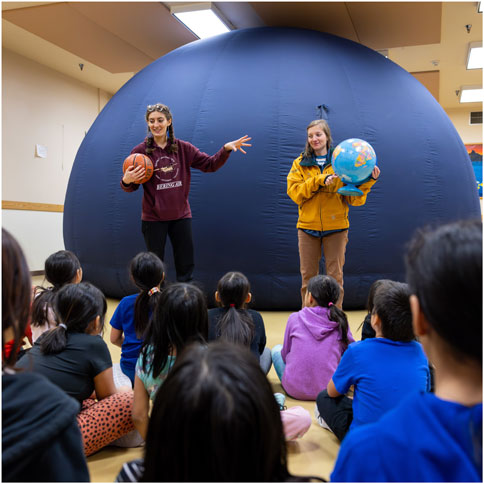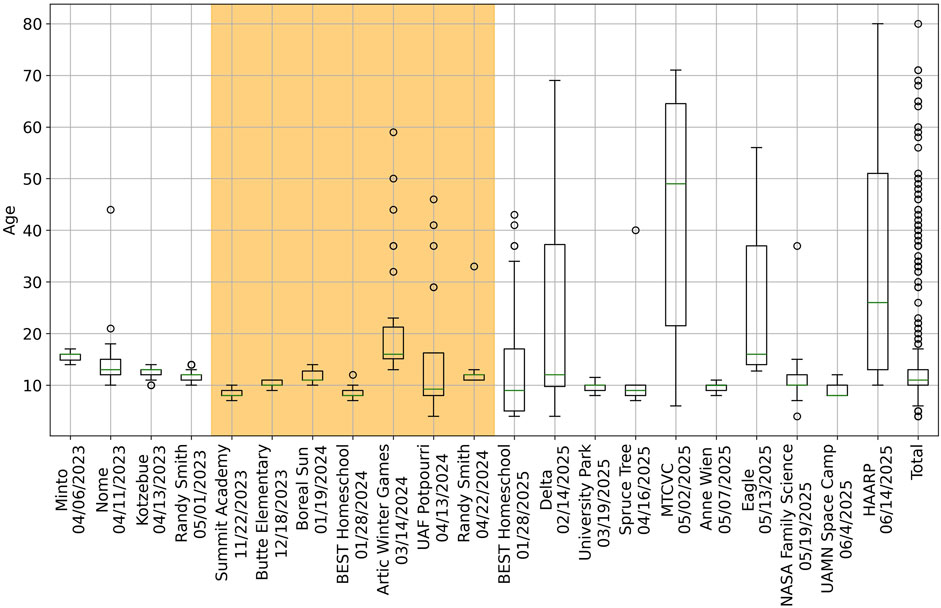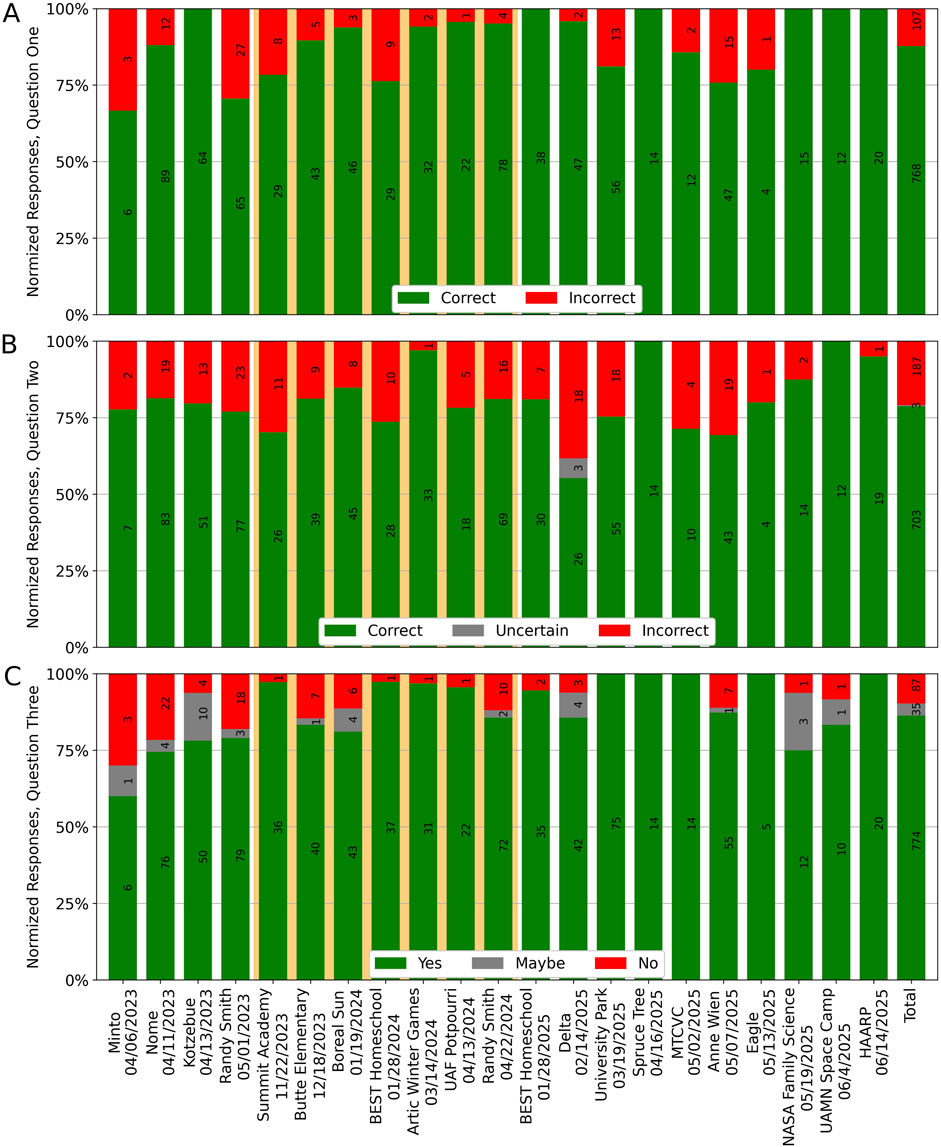- 1Geophysical Institute, University of Alaska, Fairbanks, AK, United States
- 2Oregon State University, Corvallis, OR, United States
The University of Alaska, Fairbanks has operated a portable planetarium for nearly two decades. This planetarium has visited remote communities, both on and off Alaska’s limited road network, teaching heliophysics and astronomy concepts to students and the public. Over the past 3 years, 33 events have reached thousands of people. At 21 of these, voluntary questionnaires were given to attendees after a planetarium show. These short questionnaires have only four questions, covering science comprehension and enthusiasm, as well as limited demographic information. In this work the results from 902 questionnaires are presented, together with lessons learned from the variety of events and locations the planetarium has visited since 2023. Half of the questionnaire responses are from visitors aged 10–13, highlighting our focus on elementary and middle school students and the sound system has been improved as suggested from comments left on the questionnaire.
1 Introduction
Alaska presents unique challenges for education outreach due to the state’s large scale and many rural communities. Many of these isolated communities are only accessible by boat, seasonal trails, or air. Since 2007, the University of Alaska, Fairbanks (UAF) and the Geophysical Institute have operated a portable, inflatable planetarium (seen in the background of Figure 1) to enable engaging and interactive science lessons to these remote areas. Over the years, the planetarium has visited over 50 schools and public events, including many programs in communities off the road network. The location and time of the events since 2023 can be seen in Figure 2, with three locations being completely off the road network: Kotzebue, Nome, and Nulato.

Figure 1. Presenters Rahsha Kerven and Kalee Meurlott explaining the phases of the Moon to students in Nome, Alaska. Photo by Rae Beltran.

Figure 2. The locations where the planetarium has visited since 2023 are shown in panel (A), and indicate where the questionnaire responses are taken from. Fairbanks has locations both with and without responses. Panel (B) shows a timeline of planetarium shows, with the Heliophysics Big Year highlighted in orange. Planetarium shows with questionnaire responses (green circles) are shown above the central line, and shows without any questionnaire responses (red circles) are shown below the central line.
A planetarium show begins with a brief orientation, covering safety and behavior inside the inflatable dome. Once everyone is inside, the show begins with the daytime sky over Alaska. The effects of the atmosphere is then removed and the sun, planets, and stars are visible. A brief presentation of constellations covers their story telling and navigational uses. Shows have been tailored to address specific science and cultural topics, such as an event at Fairbanks’ Morris Thompson Cultural and Visitor Center (MTCVC). The planetarium program occurred during the book release event for In the Footsteps of the Traveller: The Astronomy of Northern Dene (Cannon, 2025), which details indigenous astronomies from communities in Alaska and Canada. While the Gwich’in Yahdii constellation is not loaded in the Digitarium software, a portion of the presentation was dedicated to locating the constellation in the night sky and identifying its features.
After the constellation portion of the program, the solar system tour begins by “flying” from the surface of the Earth to the Sun. Sun spots are pointed out and the background of coronal mass ejections and the solar wind is explained. The term “heliophysics” is introduced and defined for the attendees as well. Over the course of the tour, facts about the planets are presented, including each planet’s magnetic field, atmosphere, and their aurora (or lack thereof). Most of the time is spent on the Earth’s stop on the tour, where the phases of the Moon and aurora are discussed. Depending on the available time, a portion of a video produced by the Geophysical Institute’s Education Outreach Office covers both the cultural and the scientific aspects of the aurora (McGilvary et al., 2016).
The geometry of eclipses has also been a topic at certain events, such as the 2024 Best Homeschool and 2024 Randy Smith Middle School programs. Students could see how the Moon’s shadow misses the Earth during new moon phases, except during eclipses. The shadow the Moon casts on the Earth can be seen moving across the surface. While most of the students did not see totality during the Heliophysics Big Year eclipses, they are prepared for the next total solar eclipse in the United States, which will be visible in Alaska on March 30, 2033.
Following the solar system tour, the presenters take questions from the audience. The flexibility and manual control of the Digitarium program allows for the presenters to fly back to a planet and address most questions. Once the show is complete, the attendees are guided out and often asked to complete a voluntary questionnaire. In this work, we present the results of the post-show questionnaires collected over the past 3 years, share lessons learned, and suggest future directions for UAF’s portable planetarium.
2 Methods
The planetarium uses Digitalis’s Digitarium Theta Planetarium software, which comes with several videos, constellation visualizations, and the planets, major moons, and dwarf planets of the solar system. The show is projected onto one of our two domes, a large (6 m diameter) and small (4 m diameter) dome. These domes have a capacity of
The planetarium program covers a range of space science topics, including constellations, moon phases, eclipses, the physics and origins of the aurora, and the solar system. The show duration ranges from 15 to 45 min depending on the available time and audience. The shows are guided by live presenters, knowledgeable in space physics, who may answer questions and engage the audience using interactive lessons. Each presenter has their own style and presents the main topics in varying levels of detail depending on the audience’s age, questions, current observing opportunities, and teacher requests. While the content is typically presented for K-12 audiences, during public events all ages have been welcomed into the planetarium. The content of the presentations varies with age, with K-3 students typically given shorter and more visually focused shows while 4–12 students are given more detailed science content and more time for questions. After the show, questionnaires are typically handed out and some programs include activities outside of the dome, such as aurora bracelet making and coloring sheets (Schoening et al., 2016). The questionnaire is provided on a half sheet of paper along with a pencil. The questions are listed below:
Q1. What three components are needed for Earth to have an aurora?
Q2. What do you think? Is Earth the only planet that can have aurora?
Circle one: Yes No.
Q3. After visiting the planetarium, are you more interested in learning about the aurora, sun, or space?
Circle one: Yes No.
Optional:
Please tell us your age:
Questions one and two are designed to measure the comprehension of the some of the heliophysics topics covered during the show. Question three evaluates enthusiasm and interest in heliophysics topics after attending a planetarium show, and question four collects limited demographic information. While the last question is explicitly marked as optional, the entire questionnaire is voluntary, and some attendees wrote answers other than yes or no for questions two and three. The questionnaire also provides an opportunity for attendees to give feedback to the planetarium organizers.
3 Results
The questionnaire responses represent 21 out of 33 planetarium programs since 2023, with 902 total responses. A visual summary of the planetarium events since 2023 can be seen in Figure 2. While most of the planetarium shows have been given at Fairbanks area schools, there have been presentations to schools in Nome, Kotzebue, Minto, Nulato, Eielson, and Palmer. The school in Eagle had a field trip to Fairbanks, which included a planetarium visit. Public events in Fairbanks, Palmer, Delta, and at the HAARP facility extend both the geographic and age range of planetarium visitors. The distributions in age (see Figure 3) show that most of the responses are from elementary through high school students, though there are outliers which typically represent parents, teachers, or staff at school events.

Figure 3. The age distribution from the questionnaires from each planetarium program as well as the total. The median age is shown by the green line, the box represents the interquartile range (IQR), the whiskers show the minimum or maximum, and circles show outliers (defined by being beyond the IQR by one and a half IQRs). Responses collected during the Heliophysics Big Year are in the shaded orange region. Outliers typically represent parents, teachers, or staff who have taken the questionnaire.
The responses to each question described in the previous section are summarized in Figure 4. Panel (A) shows that in all but two programs (Minto and the 2023 Randy Smith programs) more than 75% respondents correctly identified that Earth needs solar wind, magnetic field, and gases to create aurora. In more than 75% of the planetarium programs, over 75% of the respondents correctly answered that planets other than the Earth can have aurora (Figure 4B). Across all the planetarium programs, more than 85% of the respondents indicated that they were interested in learning more about the aurora, sun, or space (Figure 4C).

Figure 4. Panels (A), (B), and (C) show the normalized responses to questions one, two, and three respectively; responses collected during the Heliophysics Big Year are in the shaded orange region. The number of each response type is shown in the center of each bar and the total results from all questionnaires are shown on the rightmost column.
4 Discussion
While some of these events have a low number of responses (e.g., Eagle and Minto), the responses represent most of the family groups who attended these events. Fifty percent of the responses come from attendees with ages between 10 and 13, representing late elementary to early middle school students. The public events, such as the 2024 Arctic Winter Games, Delta and MTCVC events, and HAARP Open House reach attendees with a broader age range. Overall, most attendees learn fundamental aspects of the aurora and heliophysics, and are excited to learn more about space physics. The questionnaires also provide for an anonymous, freeform feedback channel to the planetarium organizers and presenters. It is from these suggestions that improvements have been made, such as adding a larger speaker and microphone so that attendees can better hear and understand the presenters. The improved audio system has been well received, as attendees with hearing loss can now hear the presenters over background noise, such as the fan, which keeps the dome inflated during use, and the sounds of people talking outside the planetarium dome.
An important lesson from the Nulato planetarium program is the need to be aware of other events on the calendar when planning public events, especially in rural communities where life is centered around subsistence. While questionnaires were not collected at Nulato, most of the students and school staff were engaged, asking questions, and excited to see the program. However, the school event and evening public event were scheduled for the opening day of moose hunting season in Alaska’s Game Management Unit 21D, which surrounds Nulato. This meant many of the students were anxious, as the next day was a half school day so they could go with their families to hunt over the weekend. Only two non-students attended the planetarium during the evening public event, as many were preparing for the weekend.
The extreme seasonality and limited access to many communities in Alaska does not directly constrain the scheduling of events; shows have been given when the outdoor temperature was below
After a hiatus during the pandemic, the portable planetarium program has been gradually ramping back up. There are more planetarium programs planned in the remainder of 2025 and in 2026, with new communities and schools on the schedule. Providing a pre-questionnaire to teachers before school visits has also been discussed to gain a better understanding of the effectiveness of the planetarium programs. Also, with a 65-seat brick-and-mortar planetarium nearing completion in Fairbanks, the portable planetarium will be available to serve even more remote communities across Alaska. The questionnaires will continue to be collected, and with the additional data, future studies could potentially focus on differences between communities on and off the road network or the differences between school and public events.
Data availability statement
The datasets presented in this study can be found in online repositories. The names of the repository/repositories and accession number(s) can be found in the article/supplementary material.
Ethics statement
Written informed consent was obtained from the individual(s) for the publication of any potentially identifiable images or data included in this article.
Author contributions
AS: Formal Analysis, Data curation, Visualization, Writing – review and editing, Writing – original draft, Investigation. KM: Investigation, Methodology, Data curation, Supervision, Writing – review and editing, Resources, Funding acquisition, Project administration. SS: Investigation, Writing – review and editing. KS: Writing – review and editing, Investigation, Data curation. KT: Investigation, Writing – review and editing. AC: Investigation, Writing – review and editing. LM: Resources, Supervision, Writing – review and editing, Project administration. VS: Supervision, Writing – review and editing, Methodology. HF: Writing – review and editing, Supervision, Methodology.
Funding
The author(s) declare that financial support was received for the research and/or publication of this article. A portion of this program was funded by the NASA Heliophysics Education Activation Team (HEAT) cooperative agreement, number 80NSSC21K1174. Funding also comes through the Geophysical Institute. The remainder of the funding was generously supported by schools and organizations requesting the planetarium program. AS is funded by NSF Grant: AGS-2350463.
Acknowledgments
We acknowledge the Alaska Native nations upon whose ancestral lands our campuses reside. In Fairbanks, our Troth Yeddha’ Campus is located on the ancestral lands of the Dena people of the lower Tanana River. We would like to thank the GI Communications staff, school and event staff at the program sites, and all the other volunteers throughout the years that have contributed to the program’s success with logistics and technology support, crowd control and more. The dataset collected for this study can be found in the Zenodo (https://doi.org/10.5281/zenodo.16916196).
Conflict of interest
The authors declare that the research was conducted in the absence of any commercial or financial relationships that could be construed as a potential conflict of interest.
Generative AI statement
The author(s) declare that no Generative AI was used in the creation of this manuscript.
Any alternative text (alt text) provided alongside figures in this article has been generated by Frontiers with the support of artificial intelligence and reasonable efforts have been made to ensure accuracy, including review by the authors wherever possible. If you identify any issues, please contact us.
Publisher’s note
All claims expressed in this article are solely those of the authors and do not necessarily represent those of their affiliated organizations, or those of the publisher, the editors and the reviewers. Any product that may be evaluated in this article, or claim that may be made by its manufacturer, is not guaranteed or endorsed by the publisher.
References
Cannon, C. M. (2025). In the footsteps of the traveller: the astronomy of northern dene. Winnipeg, Canada: University of Manitoba Press.
McGilvary, L., Li, Q., Hayward, D., Akpik, F., and Glen, P. (2016). Kiuġuyat: the northern lights. Fairbanks, United States: UAF Geophysical Institute.
Keywords: planetarium, heliophysics, outreach, education, public engagement, K-12 education
Citation: Smith AR, Meurlott K, Sakhalkar S, Storm K, Taylor K, Chaudhuri A, McGilvary L, Sellers V and Fischer H (2025) Northern Alaska’s portable planetarium before, during, and after the heliophysics big year. Front. Astron. Space Sci. 12:1697118. doi: 10.3389/fspas.2025.1697118
Received: 01 September 2025; Accepted: 14 October 2025;
Published: 21 October 2025.
Edited by:
Gareth Perry, New Jersey Institute of Technology, United StatesReviewed by:
Amy Keesee, University of New Hampshire, United StatesAlexa Jean Halford, National Aeronautics and Space Administration, United States
Copyright © 2025 Smith, Meurlott, Sakhalkar, Storm, Taylor, Chaudhuri, McGilvary, Sellers and Fischer. This is an open-access article distributed under the terms of the Creative Commons Attribution License (CC BY). The use, distribution or reproduction in other forums is permitted, provided the original author(s) and the copyright owner(s) are credited and that the original publication in this journal is cited, in accordance with accepted academic practice. No use, distribution or reproduction is permitted which does not comply with these terms.
*Correspondence: Austin R. Smith, YXNtaXRoMTU1QGFsYXNrYS5lZHU=
 Austin R. Smith
Austin R. Smith Kalee Meurlott1
Kalee Meurlott1 Victoria Sellers
Victoria Sellers Heather Fischer
Heather Fischer